#utility patent application
Explore tagged Tumblr posts
Text
Utility Patent Illustration Services | USPTO-Compliant Drawings by The Patent Experts
Get professionally crafted utility patent drawings that meet all USPTO requirements with The Patent Experts. Our team specializes in creating detailed, accurate, and fully compliant illustrations that enhance your patent application’s success. Whether you need drawings for mechanical devices, processes, software, or complex inventions, we ensure precision and legal clarity. Learn how our expert process, advanced tools, and client-focused service make your innovation patent-ready.
Know More
Ready to elevate your patent submission? Order professional utility patent drawings now at thepatentexperts.com/service/utility-patent-drawings/2 and ensure full compliance with USPTO requirements.
#utility patent drawings#USPTO patent illustration#patent drawing services#professional patent illustrator#utility patent application#compliant patent illustrations#technical patent drawings#The Patent Experts
2 notes
·
View notes
Text
Utility Patent in Texas - Affordable Patent Agency Secure your invention with a Utility Patent in Texas. Affordable Patent Agency provides expert patent filing, searches, and legal assistance to protect your intellectual property. Visit - https://affordablepatentagency.com/understanding-utility-patent/
#Utility Patent in Texas#Patent Agent in Texas#Patent Attorney in Texas#Patent Application in Texas#Affordable Patent Agency
0 notes
Text
Digital Suntech offers top-notch patent illustration and drawing services designed to meet the highest standards of clarity and precision required for patent applications. Our expert team specializes in creating detailed, accurate, and professional patent drawings that comply with the stringent guidelines of patent offices worldwide. Whether it's utility patents, design patents, or any other type, we ensure that every illustration enhances the quality of your submission, aiding in the clear communication of your invention's unique features. With a focus on both technical accuracy and visual appeal, Digital Suntech is your go-to partner for reliable and efficient patent illustration services.
#patent illustration services#patent drawing services#digital suntech#utility patents#design patents#patent applications
0 notes
Text
Illustrating Innovation: Utility Drawings in Patent Applications - Digital Suntech
Digital Suntech is at the forefront of innovation, specializing in cutting-edge digital solutions for patent applications. Our team of experts understands the critical role utility drawings play in securing intellectual property rights and offers comprehensive services to ensure your inventions are accurately and effectively represented. Whether you need assistance with drafting utility drawings, navigating the patent application process, or maximizing the impact of your innovations, Digital Suntech is here to help. Contact us today to learn more about how we can support your intellectual property needs.

#utility drawings#patent drawing services#patent application#innovation#patent drawing#patent illustration#intellectual property#patent protection
0 notes
Text
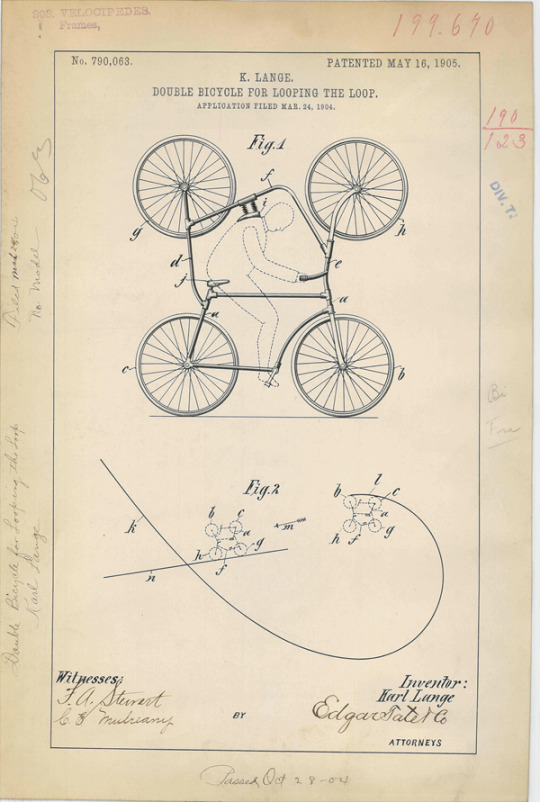
Patent Drawing for K. Lange's Double Bicycle for Looping the Loop
Record Group 241: Records of the Patent and Trademark OfficeSeries: Utility Patent Drawings
208. VELOCIPEDES.
Frames
199.670
No. 790,063 Patented May 16, 1905.
K. Lange.
Double Bicycle for Looping the Loop.
Application Filed Mar. 24, 1904
Fig. 1
[figure of a person sitting on a bicycle with a second bicycle testing upside down on the person's back]
Fig. 2
[illustration of the bicycle on a flat plane and on a curved surface where it goes upside down]
Witnesses:
F. A. Stewart
C. E. Mureany
Inventor:
Karl Lange
Edgar Tate & Co.
BY
Attorneys
Passed Oct. 28-04
[left side] Double Bicycle for Looping the Loop Karl Lange Filed Mch 24 04 no. Model 063
275 notes
·
View notes
Text
The Evolution of the Tesla Coil

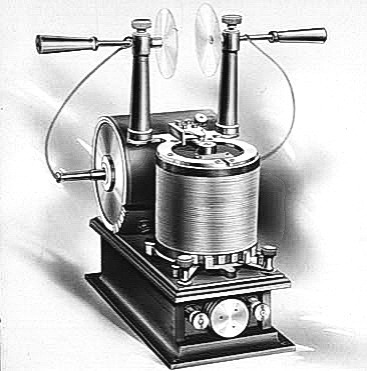
Nikola Tesla invented the Tesla coil as part of his exploration into lighting, wireless power transmission, and radiofrequency experiments. He developed the coil to produce high-voltage, low current, high-frequency electricity. The Tesla coil consists of primary and secondary coils that are inductively coupled, and the circuit is designed to resonate at a specific frequency. This resonance enhances the efficiency of energy transfer between the coils, enabling the generation of high-voltage, high-frequency alternating current.
His first Tesla coil was a bipolar coil created around 1891, and was demonstrated before scientific institutes from 1891-1893. His patents reveal that they were essentially intended for light production using both high frequency and high voltage at the same time. He also mentions in his patents how he discovered that a single wire could be used to light a light bulb. Generally, light bulbs require two wires to operate – one for the positive (live or hot) and one for the negative (neutral). He also discarded wires completely lighting bulbs wirelessly. Tesla improved upon the bipolar coil over many years using them for gas engine ignition, wireless, ozone production, and to create undamped waves.
In 1893, Tesla developed the bifilar spiral coil, which is a type of coil wound with two parallel wires, known as bifilar winding. The wires are wound side by side in a spiral pattern, maintaining close proximity throughout the coil. It was built in an attempt to avoid the employment of condensers, which are expensive and difficult to maintain. The coils themselves were meant to accomplish the same ultimate object as the condensers.

In 1894, Tesla evolved his coil into a conical coil. A conical coil refers to a coil or winding in the shape of a cone. These coils were sometimes employed in his wireless power transmission experiments and other electrical investigations. The shape of the coil can influence its inductance, capacitance, and resonance properties, impacting its performance in different applications. This coil allowed Tesla to reach tensions of 1 million volts.
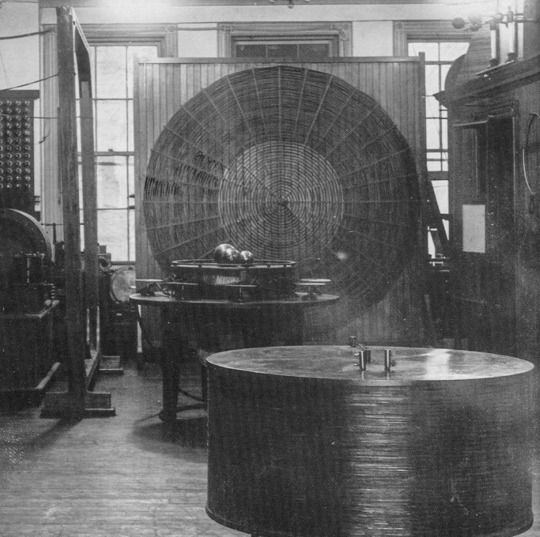
In 1897, Tesla developed the flat spiral coil, similar to his bifilar coil. This type of coil forms a flat, spiral pattern. The specific shape and dimensions of the coil can influence its inductance and other electrical properties. The main reason Tesla started using flat spiral coils was because they were relatively safe, since the highest potential terminal is at the center, and also because they better suppressed the sparks, which were essentially losses in the circuit, allowing him to achieve higher voltages:
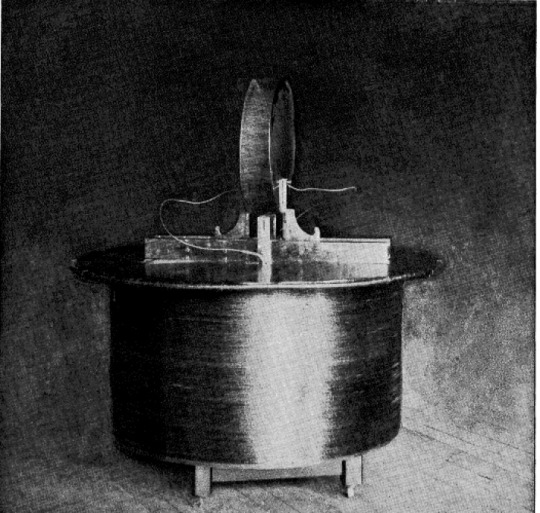
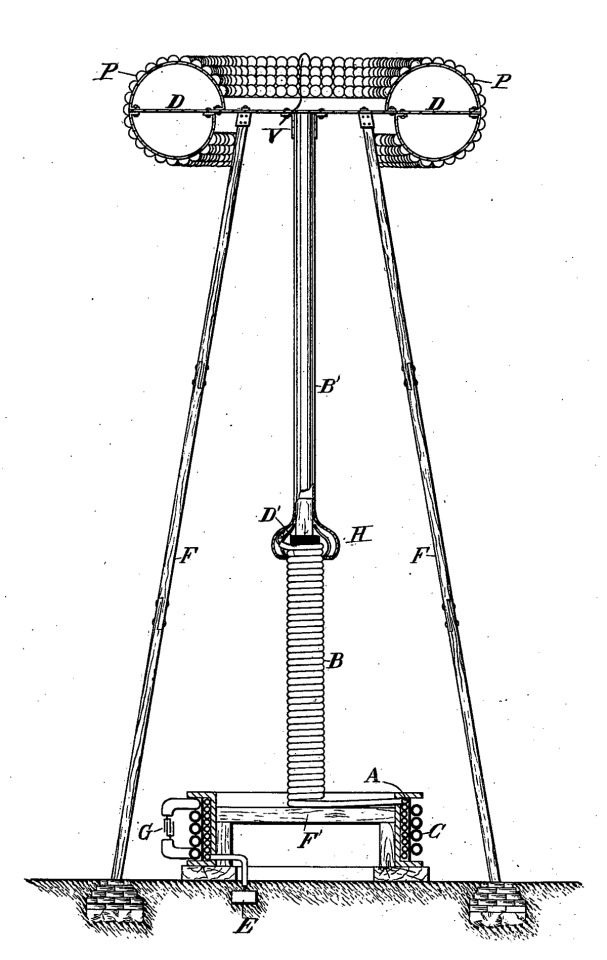
Another version of his coils was his Helical coil. A helical coil is a coil wound in the shape of a helix or spiral. The helical coil configuration is characterized by the wires being wound around a cylindrical form in a continuous spiral pattern. Tesla utilized helical coils throughout the late 1890s and in his Colorado Springs Experiments. The coils were used in his wireless transmission experiments, and he employed helical resonators to investigate the behavior of electromagnetic waves. The helical shape offers specific electrical properties and can influence the resonance and performance of the coil in certain applications.
Finally, the Tesla coil would eventually evolve into his Magnifying Transmitter. Tesla designed it as part of his wireless power transmission experiments. The magnifying transmitter was intended to efficiently transmit electrical energy over long distances without the need for wires. The system involved a large coil, often called the magnifying transmitter coil, which could produce high-frequency, high-voltage electrical currents. Tesla believed that this technology could revolutionize global communication and provide a means for delivering electrical power wirelessly by using the earth itself as a conductor.
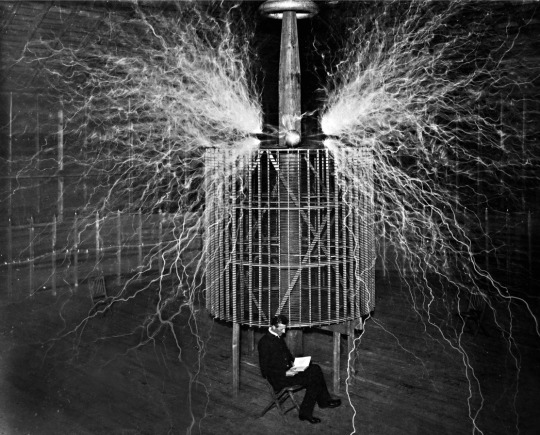
The magnifying transmitter would become his Wardenclyffe Tower. Unfortunately, Tesla ended up lacking the investments and funds to finish his work in its entirety. Some say he failed because his idea didn’t work, but that’s not true at all because his Colorado experiments proved that they did. In his head, the transmission of energy was a matter of engineering. If he had a machine that could send energy 20 miles, then he could build a machine that could send energy a thousand miles. As long as he understands the motive power, he could build a machine that will do all that he requires of it. He simply underestimated the cost of his system. His failures to finish his work would leave him with the public persona as being the mad scientist who had unrealistic ideas for the future.
Ultimately, Tesla would not realize his dream of providing humankind with cheap, unlimited energy in his lifetime; however, his legacy forever lives on through the incredibly impactful experiments, and the evolution of the Tesla Coil.
“Technical invention is akin to architecture and the experts must in time come to the same conclusions I have reached long ago. Sooner or later my power system will have to be adopted in its entirety and so far as I am concerned it is as good as done. If I were ever assailed by doubt of ultimate success I would dismiss it by remembering the words of that great philosopher, Lord Kelvin, who after witnessing some of my experiments said to me with tears in his eyes: ‘I am sure you will do it.’”--Nikola Tesla
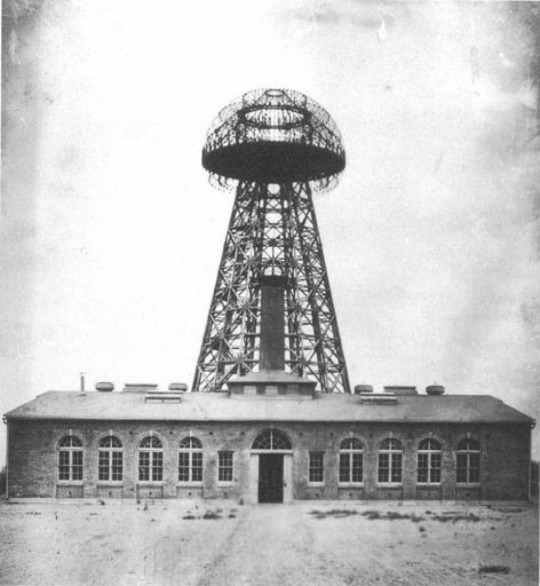
#nikola tesla#science#history#electricity#invention#wireless#energy#power#Tesla coil#quotes#ahead of his time#ahead of our time
239 notes
·
View notes
Note
There's a shade of forest green that should be under your trademark tbh, that is your green and I think of you every time I see it. Also clever wordplay and lawyer memes™️
fun fact, colors can be trademarked so long as they've acquired secondary meaning (like Post-it yellow is trademarked, as are the red bottoms on Louboutin heels) and the color doesn't have a utility (e.g., it's cheaper or better to make the product that color, or some other useful purpose)... all of which to say, get enough people to see that green as "my" green, and maybe I'll send in an application to the US Patent and Trademark Office ;)
#granted it would also have to serve a purpose of identifying a specific good or service#tho it sounds like that service is making puns
5 notes
·
View notes
Text
Polludrone
Polludrone is a Continuous Ambient Air Quality Monitoring System (CAAQMS). It is capable of monitoring various environmental parameters related to Air Quality, Noise, Odour, Meteorology, and Radiation. Polludrone measures the particulate matter and gaseous concentrations in the ambient air in real-time. Using external probes, it can also monitor other auxiliary parameters like traffic, disaster, and weather. Polludrone is an ideal choice for real-time monitoring applications such as Industries, Smart Cities, Airports, Construction, Seaports, Campuses, Schools, Highways, Tunnels, and Roadside monitoring. It is the perfect ambient air quality monitoring system to understand a premise's environmental health.
Product Features:
Patented Technology: Utilizes innovative e-breathing technology for higher data accuracy.
Retrofit Design: Plug-and-play design for ease of implementation.
Compact: Lightweight and compact system that can be easily installed on poles or walls.
Internal Storage: Internal data storage capacity of up to 8 GB or 90 days of data.
On-device Calibration: On-site device calibration capability using built-in calibration software.
Identity and Configuration: Geo-tagging for accurate location (latitude and longitude) of the device.
Tamper-Proof: IP 66 grade certified secure system to avoid tampering, malfunction, or sabotage.
Over-the-Air Update: Automatically upgradeable from a central server without the need for an onsite visit.
Network Agnostic: Supports a wide range of connectivity options, including GSM, GPRS, Wi-Fi, LoRa, NBIoT, Ethernet, Modbus, Relay, and Satellite.
Real-Time Data: Continuous monitoring with real-time data transfer at configurable intervals.
Weather Resistant: Durable IP 66 enclosure designed to withstand extreme weather conditions.
Fully Solar Powered: 100% solar-powered system, ideal for off-grid locations.
Key Benefits:
Robust and Rugged: Designed with a durable enclosure to withstand extreme climatic conditions.
Secure Cloud Platform: A secure platform for visualizing and analyzing data, with easy API integration for immediate action.
Accurate Data: Provides real-time, accurate readings to detect concentrations in ambient air.
Easy to Install: Effortless installation with versatile mounting options.
Polludrone Usecases:
Industrial Fenceline: Monitoring pollution at the industry fenceline ensures compliance with policies and safety regulations, and helps monitor air quality levels.
Smart City and Campuses: Pollution monitoring in smart cities and campuses provides authorities with actionable insights for pollution control and enhances citizen welfare.
Roads, Highways, and Tunnels: Pollution monitoring in roads and tunnels supports the creation of mitigation action plans to control vehicular emissions.
Airports: Pollution and noise monitoring at taxiways and hangars helps analyze the impact on travelers and surrounding neighborhoods. Visit www.technovalue.in for more info.

#AirQualityMonitoring#CAAQMS#EnvironmentalMonitoring#SmartCitySolutions#RealTimeData#PollutionControl#IoTDevice
2 notes
·
View notes
Text
The Significance of Gastrointestinal Stents in the Treatment of Digestive Disorders
Digestive disease has the potential to significantly detract from a patient's quality of life, bringing with it often discomfort, nutritional issues, and severe health consequences. For patients with these afflictions, however, Gastrointestinal Stents have proven an invaluable medical treatment, bringing comfort and functionality to patients experiencing GI tract obstructions or strictures. We at Mitra Industries are pleased to be leading the way with this critical medical development.
Gastrointestinal Stents, such as Esophageal Stents, are tiny tube-like stents placed in the GI tract to keep narrowed or blocked passages patent. The stents keep the esophagus, stomach, small intestine, or colon, depending on the condition, from becoming blocked, depending on where they are used. In disease states like cancer of the esophagus, peptic stricture, or post-operative strictures, putting in a stent can considerably alleviate symptoms like dysphagia (trouble swallowing) and allow one to resume eating normally.
Being one of the reliable providers of Esophageal Stents India, Mitra Industries supplies precision-made stents that are engineered for maximum patient safety, durability, and ease of deployment. Our stents are designed to offer instant relief with minimal pain, making a real difference in emergency as well as long-term care situations.
Another innovation in treating intricate digestion disorders is the application of EUS guided stents (Endoscopic Ultrasound-guided stents). This new technique integrates real-time visualization with exact stent positioning, especially useful in the treatment of pancreatic fluid collections, biliary stricture, or gastrointestinal leaks. EUS-guided interventions provide highly specific treatment with reduced complications and accelerated recovery times, particularly when utilized with high-quality, specifically designed stents.
At Mitra Industries, we are committed to assisting healthcare providers with innovative stenting solutions that maximize procedural efficacy and patient success. We collaborate with gastroenterologists and endoscopy facilities nationwide to guarantee access to the most credible and innovative products.
Summarily, Gastrointestinal Stents play a crucial role in the management of digestive disorders. From alleviating symptoms in oncology patients to facilitating minimally invasive drainage treatment, stenting is a state-of-the-art, effective modality of care for the GI tract. Supported by technological advancement and medical knowledge, Mitra Industries stays focused on digestive wellness in India—one stent at a time.
3 notes
·
View notes
Text
InventHelp: How to Patent an Invention Idea?
As a new inventor, moving forward and getting started with your invention idea can seem like a daunting and difficult task. Often, you have no idea who to turn to and what steps to take because of your inexperience in the world of new inventions. This is why a lot of people with great invention ideas decide to seek help and support from those with expertise and experience in this field.
Of course, finding the right support and assistance can also be challenging if you have no experience in this field. The new invention services provider you choose can have a huge impact on your first experience as a new inventor in many ways. It can affect everything from the level of support you get to your confidence levels and even your finances. So, you need to ensure you put plenty of thought into this matter and find a provider that has a solid reputation and background as well as a proven track record.
#InventHelp #InventHelp Patent #InventHelp Patent Services #InventHelp Inventions #InventHelp Patent Attorney #InventHelp Patent Invention #InventHelp Patent An Idea #InventHelp Patent Protection #InventHelp Invention Ideas #InventHelp Innovation #InventHelp Technology #InventHelp Inventors #InventHelp Products
Many new inventors stumble upon InventHelp when they are looking for a provider to assist them with their first invention journey. This is a provider that has been around for decades, so it is little wonder that so many new inventors take an interest in the company. However, as with any provider you consider, it is vital that you do your research and find out as much as you can about the company before you make any decisions. There are lots of things that new inventors are keen to find out about InventHelp and the services that are offered. This then makes it easier to make informed choices and ensure you have the right expert support to guide you through your first journey.
In this article, we will explore some of the key things that new inventors are keen to find out about InventHelp.
Some Popular Patent Questions and InventHelp Services
There are many questions that new inventors have when researching InventHelp and its services. As a new inventor, you can benefit hugely by looking at some of the most common questions and answers as well as conducting your own independent research. This helps to ensure you choose the right provider for your needs, and that you can benefit from peace of mind when it comes to your selection. Some of the most popular questions and answers regarding this provider are:
What is a Patent?
A patent is a legal right granted by a government to an inventor or assignee, providing exclusive rights to an invention for a limited period of time. It is a form of intellectual property protection that allows the inventor to prevent others from making, using, selling, or importing the patented invention without their permission.
Patents are granted in recognition of new and useful inventions that meet certain criteria. To be eligible for a patent, an invention must generally be novel (new), non-obvious (not obvious to someone skilled in the field) and have industrial applicability (useful in an industry or field).
A patent gives the inventor the right to control the use and commercialization of their invention, providing a legal framework to protect their investment in research, development, and innovation. It allows inventors to potentially profit from their inventions by licensing or selling the patent rights to others.
Patents are typically granted for a fixed period of time, which varies depending on the type of patent and the jurisdiction. In many countries, utility patents (also known as invention patents or utility models) are granted for 20 years from the filing date, while design patents protect the ornamental design of a functional item for a shorter duration.
It is important to note that obtaining a patent requires a formal application process and examination by a patent office to determine the patentability of the invention. Consulting with a qualified patent attorney or agent is recommended to navigate the complexities of the patent system and maximize the chances of obtaining a patent.
What Are the Different Types of Patents?
There are generally three main types of patents granted by most patent offices around the world:
1. Utility Patents: Utility patents, also known as invention patents or utility models, are the most common type of patent. They cover new and useful processes, machines, compositions of matter, or improvements thereof. Utility patents protect the functional aspects of an invention, such as how it works or how it is made. They provide exclusive rights to the inventor to prevent others from making, using, selling, or importing the patented invention for a period of time, typically 20 years from the filing date.
21 notes
·
View notes
Text
3D vs 2D Design Patent Illustrations — Which One Should You Use? | The Patent Experts
Introduction
Design is more than just aesthetics — it’s an identity, a selling point, and sometimes, a competitive edge. That’s why securing a design patent is crucial for inventors, startups, and even established brands. But here’s the kicker: a design patent isn’t just about what your product looks like — it’s about how you show what it looks like.
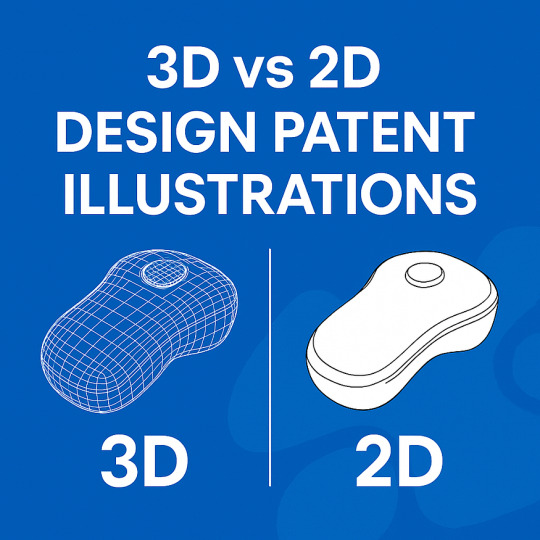
If you’re on the fence about whether to go with traditional 2D drawings or high-tech 3D renders, this blog breaks it all down. We’ll go deep into the pros, cons, use cases, and real-world insights so you can make the smartest move for your patent strategy.
What Is a Design Patent?
A design patent protects the ornamental appearance of a product. Unlike utility patents, which safeguard how something works, design patents focus solely on how something looks.
Let’s say you invented a uniquely curved smartphone or a stylish kitchen gadget. You can’t patent the function (unless it’s new), but you can protect its visual features — its curves, edges, and shape.
But here’s the catch: your application has to visually describe the design in minute detail, leaving no room for misinterpretation. And that means your illustrations need to be on point.
Why Are Patent Illustrations So Critical?
Patent examiners don’t guess. They evaluate exactly what’s shown in your illustrations. These drawings:
Define the scope of your protection
Get referenced in court, if needed
Are compared against prior designs
If your illustrations miss a line or show something unclear? Boom — your application could get rejected or your patent could be challenged later.
So yeah, getting the illustrations right is mission-critical.
What Are 2D Design Patent Illustrations?
2D patent illustrations are the traditional, go-to format. These are flat, orthographic views — think top, bottom, front, back, left, right, and isometric (optional).
Each view is like a piece of a puzzle. Together, they form a complete picture of the object.
Benefits of 2D Illustrations
Cost-effective for simple designs
Faster turnaround times
Easier to revise for basic geometry
Meets USPTO guidelines when done right
Limitations of 2D Illustrations
Doesn’t capture depth or complex curvature well
Can be confusing for organically shaped products
Requires multiple views to convey full shape
Can lead to inconsistent line weights if drawn manually
Example
Imagine you’re patenting a rectangular tissue box. A 2D drawing can handle this easily. Six clean, orthographic views and you’re good to go.
But now imagine you’ve designed a sleek new gaming mouse with complex curves and textured surfaces. That’s where 2D might fall short.
What Are 3D Design Patent Illustrations?
3D design patent illustrations are perspective views created from a digital model. These offer depth, dimensionality, and a far more realistic view of the product.
The 3D model is created using CAD (Computer-Aided Design) software, then static images of different views are extracted and refined for submission.
Advantages of 3D Illustrations
Easier to understand complex shapes and textures
Excellent for curved or intricate designs
More consistent views (all from the same model)
Reusable for marketing, prototyping, and 3D printing
Drawbacks
Higher cost due to modeling time
Requires advanced software and skill
Longer turnaround for detailed models
Must be converted to USPTO-compliant 2D format
Real-World Case Study
A startup designing ergonomic headphones used 3D illustrations to show the contour, foldability, and integration of buttons. Their initial 2D submission was flagged for unclear views. After switching to 3D-rendered outputs, the USPTO accepted the drawings, and their patent was granted within six months.
When Should You Use 2D vs 3D?
Choosing between 2D and 3D comes down to:
Design complexity
Your budget
USPTO compliance
Go with 2D if:
Your design is flat or symmetrical
You want to save money and time
Your product looks similar from most angles
Go with 3D if:
Your design is complex or curved
You want highly detailed, realistic visuals
You need consistency across multiple angles
In many cases, applicants use a hybrid strategy: creating a 3D model and extracting 2D-compliant illustrations from it.
USPTO’s Stance on 2D and 3D
The USPTO doesn’t show favoritism between 2D and 3D illustrations, as long as the drawings:
Accurately represent the design
Maintain consistency across views
Follow black-and-white format (no colors or photos)
Include proper shading, line weights, and view labels
That said, perspective views (often created from 3D models) are optional but recommended for designs with unique contours.
How Much Do Design Patent Illustrations Cost?
Let’s talk numbers.
2D Illustrations
Average Cost: $100 — $300
Good for: Straightforward, geometric designs
3D Illustrations
Average Cost: $300 — $800+
Good for: Complex shapes, consumer electronics, fashion accessories
The price can vary based on:
Number of views required
Revisions requested
Level of detail
Whether you already have a CAD model
Turnaround Time: How Long Does It Take?
Speed matters, especially if you’re in a race to file.
2D Turnaround: 2–5 business days
3D Turnaround: 4–10 business days
With 3D, you might spend more time upfront modeling, but view generation and revisions are easier once the base model is done.
Why Getting It Wrong Can Cost You Big
Submitting poor-quality or non-compliant illustrations can:
Delay your application
Result in USPTO objections
Lead to narrower protection than intended
Increase legal costs if challenged later
We’ve seen clients come to professional services after wasting time and money on DIY attempts. Don’t be that person.
How Professionals Help (and Save You Headaches)
Professional illustrators:
Know the USPTO’s rules inside out
Use advanced tools like SolidWorks, Rhino, or Adobe Illustrator
Create clean, consistent, and legally defensible visuals
Advise you on optimal view angles
They also prevent common pitfalls like:
Misaligned views
Inconsistent shading
Improper line weights
Missing views
Industry Examples
Consumer Products
Think toothbrushes, bottles, headphones. These often have subtle curves and textures — 3D is often the winner here.
Fashion Accessories
Sunglasses, bags, and jewelry require fine details and texture — a 3D model can show folds, stitching, and curves much more effectively.
Mechanical Components
2D may be enough for bolts, brackets, and flat parts. But for ergonomic tools or curved assemblies? 3D takes the cake.
Additional Insights: Legal Perspective
In IP litigation, your patent drawings may be scrutinized in court. Any ambiguity in design may weaken your case.
3D-rendered outputs, when properly converted, reduce ambiguity and provide clearer intent. This can be a critical factor in defending your rights.
Conclusion
In the battle of 3D vs. 2D design patent illustrations, there’s no one-size-fits-all answer.
If your product is simple and budget is tight, go with 2D. But if your design has curves, contours, or complex geometry, 3D is the smarter investment.
Remember, your illustrations define your patent rights — don’t cut corners here.
Looking for expert help? At The Patent Experts, we offer USPTO-compliant 2D and 3D design patent illustration services tailored to your exact needs. Whether you need high-detail 3D renderings or quick 2D sketches, our team ensures precision, speed, and compliance.
Get your design patent drawings done right
FAQs
1. Can I submit both 2D and 3D illustrations in one application? Yes, as long as they are consistent. Most applicants use 3D models to create 2D views for submission.
2. Does using 3D improve my chances of getting a patent? Not directly, but clearer visuals reduce misunderstandings and office actions, speeding up approval.
3. What file format should I submit to the USPTO? Submit static black-and-white images in PDF or TIFF format. Vector files or raw 3D models aren’t accepted.
4. Can I use photos instead of drawings? Generally, no. Photos are not accepted unless the object cannot be illustrated with line drawings, which is rare.
5. What happens if my drawings aren’t compliant? Your application may be rejected or delayed until you fix the drawings. Non-compliant illustrations can also weaken your patent rights.
#design patent illustration services#design patent drawings#patent illustrations#patent drawings#uspto#patent application#patent drafting#cad drawings#machine drawings#design patent drawing requirements#design patent drawing examples#uspto compliant drawings#professional patent drawings#utility vs design patents
0 notes
Text
Utility Patent in Texas - Affordable Patent Agency Secure your innovations with a Utility Patent in Texas. Affordable Patent Agency provides expert patent filing, search, and prosecution services to protect your intellectual property Visit- https://affordablepatentagency.com/understanding-utility-patent/
#Utility Patent in TExas#Patent Agents in Texas#PCT Patent Application in Texas#Affordable Patent Agency
0 notes
Text
I started to make a list of all patents I received during my whole career as a parent specialist (for CV) and found that landmark letter that began with the words:
"Hi! There's a new task. It's quite non-standard. We need to find all documents related to ... kettle cover of this type".

As you can see it has a counterweight. The words cannot describe how much we fucked around with this application on utility model on this kettle cover 😆
We literally had to invent this detail ourselves, since there were several already registered patents for this technical solution
So my nickname here belongs to kettle cover from this task
3 notes
·
View notes
Text
in fact, just in case my hour and a half of research can help someone else, here's the comment I posted under a cut!
I made sure that I addressed the stuff I felt able to address that they specifically asked about, ie
NIST is specifically interested in receiving input from the public pertaining to the following questions: (1) After reading through the framework and example scenarios, if needed, how could the guidance about when an agency might want to exercise march-in and the factors that an agency might consider be made clearer? (2) The framework contains many terms which have specific meanings under Bayh-Dole or in technology development and commercialization. Are the definitions provided at the beginning of the framework easy to understand? Do they aid in your ability to interpret the framework? (3) How could the framework be improved to be easier to follow and comprehend? (4) Does this framework sufficiently address concerns about public utilization of products developed from subject inventions, taking into account the fact that encouraging development and commercialization is a central objective of the Bayh-Dole Act? (5) The framework is not meant to apply to just one type of technology or product or to subject inventions at a specific stage of development. Does the framework ask questions and capture scenarios applicable across all technology sectors and different stages of development? How could any gaps in technology sectors or stages of development be better addressed?
This framework first came to my attention through the lens of pharmaceutical patents, with this framework being touted as a way to seize patents from companies that are engaging in price gouging or holding onto patents for drugs that they are not producing. The benefits of exercising march-in rights on pharmaceutical patents to increase public safety and ensure that the huge amount of money the American taxpayers have sunk into pharmaceutical research is repaid in some measure are obvious. Public health and safety should not and can not practically be in the hands of private companies who have demonstrated more care for profits than for easing human suffering and saving lives; it is absurd that, for example, diabetics like my uncle should have paid taxes their whole lives, huge proportions of which went to drug research, and now find themselves unable to afford the insulin they need to continue living. I am frankly astonished, as someone younger than the Bayh-Dole Act, to find that the federal government has possessed the right to march-in for my entire life and failed to exercise it for the good of the American people. If a more specific framework to guide agencies in when it is appropriate to march-in would help them actually exercise this right, we should by all means adopt it.
Having read through the framework several times, I find it is clear and detailed enough that I think I know how I would proceed if I worked at an agency and found myself considering whether to march-in. There are enough details and clarifications as to what kind of additional research or fact-finding should be done that the process seems, if not straight-forward, manageable. I especially appreciate the specific instances noting when it would be appropriate to consult with counsel or subject matter experts as to whether or not Bayh-Dole applies.
As a layman previously unfamiliar with Bayh-Dole, the definitions provided at the beginning of the framework were very helpful! I went back to consult them several times to ensure I knew exactly what was being talked about; they definitely aided my ability to interpret the framework. Additionally, when I found I had questions (such as what constituted a subject invention), there was usually further explication of the term within the framework when it became relevant.
I especially appreciate the further elaboration on whether or not Bayh-Dole criteria apply to pricing concerns. Previous decisions by the NIH, such as In the Case of NORVIR and In the Case of Xatalan seem to imply that disproportionately high costs do not unreasonably limit public availability of a subject invention. While there is still some room for disagreement under this framework, the extensive clarification of how and when Criterion 1 would apply to a commercialized product is both helpful and reassuring. Unfortunately, the high cost of some common subject inventions is a very pertinent factor in whether or not the public is meaningfully able to use those inventions, and I appreciate that being explicitly acknowledged by these guidelines.
As I said at the beginning of my comment, I came across this framework in the context of pharmaceutical patents. I did find that colored my perception of this framework. However, the examples in particular helped highlight areas other than drug patents which might qualify as subject inventions under Bayh-Dole. I do believe the guidelines as written clearly apply to other areas and industries as well, and are not overly specific to any one industry.
This last bit is beyond the scope of this framework--or indeed of Bayh-Dole itself, as far as I understand--but I found myself thinking about it while considering this framework. As a seamstress, I am frequently running up against the problem of previously-common textiles growing increasingly difficult to source, and supplies I consider everyday necessities no longer being manufactured. I would argue it's in the public interest to have access to quality textiles regardless of how profitable they may or may not be, at least as a cultural connection to the rich history of textile manufacture, but even I wouldn't put it in the same category as vaccines or novel water filtration methods. Still, considering I am aware of at least one developed vaccine being shelved more or less indefinitely due to lack of demand, the parallel to my own industry-specific production woes struck me.
#don't just copy my comment obviously#but even in an elevated register my comment might be. a little more understandable than the legalese
4 notes
·
View notes
Text

Patent Drawing for G. Marconi's Wireless Telegraphy
Record Group 241: Records of the Patent and Trademark OfficeSeries: Utility Patent Drawings
No. 786,132
PATENTED MAR. 28, 1905
G. MARCONI.
WIRELESS TELEGRAPHY
APPLICATION FILED OCT. 13 1903
FIG 1
(drawing of invention)
FIG 2
(drawing of invention)
Fig 3.
(drawing of invention)
Witnesses
Frank S Obur
Delos Sivedin
Inventor:
Guglielmo Marconi
By his Attorneys
Betts Betts Sheffield Betts
Sept 28 1904
(in handwritten text on left margin)
Guglielmo Marconi Wireless Telegraph
115 notes
·
View notes
Text
Indonesia Smart Cities Market Outlook for Forecast Period (2023 to 2030)
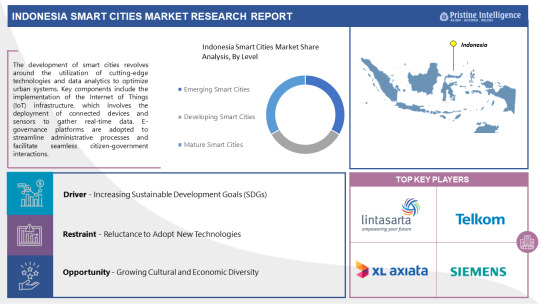
Indonesia's Smart Cities are Expected to Grow at a Significant Growth Rate, and the Forecast Period is 2023-2030, Considering the Base Year as 2022.
The development of smart cities revolves around the utilization of cutting-edge technologies and data analytics to optimize urban systems. Key components include the implementation of the Internet of Things (IoT) infrastructure, which involves the deployment of connected devices and sensors to gather real-time data.
This data is then analyzed to provide valuable insights that inform decision-making by city officials. Smart mobility solutions play a vital role in improving transportation networks, easing traffic congestion, and promoting eco-friendly transit options. E-governance platforms are adopted to streamline administrative processes and facilitate seamless citizen-government interactions.
Sustainability initiatives are emphasized, including energy-efficient buildings, renewable energy integration, waste management, and environmental conservation. Moreover, citizen engagement is fostered through digital platforms, allowing residents to actively participate in shaping urban policies and providing feedback to authorities.
One of the notable examples of smart city development in Indonesia is the "Jakarta Smart City" initiative. As the capital and most populous city in the country, Jakarta faces numerous urban challenges such as traffic congestion, waste management, and environmental pollution. To tackle these issues, the Jakarta Smart City program leverages technology and data to improve various urban services. Real-time traffic data is collected through IoT sensors to optimize transportation routes and manage traffic flow efficiently.
Waste management is enhanced by implementing smart waste bins that alert authorities when they need to be emptied, reducing unnecessary waste collection trips. Moreover, the program employs digital platforms and mobile applications to engage citizens, allowing them to access information about city services, report issues, and participate in decision-making processes. These efforts have aimed to transform Jakarta into a more sustainable, efficient, and citizen-centric smart city.
Get Full PDF Sample Copy of Report: (Including Full TOC, List of Tables & Figures, Chart) @
The latest research on the Indonesia Smart Cities market provides a comprehensive overview of the market for the years 2023 to 2030. It gives a comprehensive picture of the global Indonesia Smart Cities industry, considering all significant industry trends, market dynamics, competitive landscape, and market analysis tools such as Porter's five forces analysis, Industry Value chain analysis, and PESTEL analysis of the Indonesia Smart Cities market. Moreover, the report includes significant chapters such as Patent Analysis, Regulatory Framework, Technology Roadmap, BCG Matrix, Heat Map Analysis, Price Trend Analysis, and Investment Analysis which help to understand the market direction and movement in the current and upcoming years. The report is designed to help readers find information and make decisions that will help them grow their businesses. The study is written with a specific goal in mind: to give business insights and consultancy to help customers make smart business decisions and achieve long-term success in their particular market areas.
Market Driver:
One of the key drivers propelling the growth of the Indonesia Smart Cities market is the government's strong commitment to urban development and digital transformation. Initiatives such as the 100 Smart Cities Movement and various smart city pilot projects across the archipelago are driving the integration of smart technologies. The government's emphasis on creating efficient and sustainable urban ecosystems through the adoption of smart solutions is encouraging both public and private sector investments. As a result, there is a growing demand for intelligent infrastructure, smart transportation systems, and data-driven governance to address the challenges of rapid urbanization.
Market Opportunity:
An exciting opportunity within the Indonesia Smart Cities market lies in the development of smart transportation systems. As urbanization accelerates, traffic congestion and transportation inefficiencies pose significant challenges. Implementing smart transportation solutions, including intelligent traffic management, integrated public transportation systems, and the adoption of electric vehicles, can greatly enhance urban mobility. The integration of these technologies not only addresses current challenges but also creates a foundation for sustainable and future-ready urban transportation. Entrepreneurs and businesses investing in smart transportation solutions stand to benefit from a burgeoning market with the potential to transform how people and goods move within cities.
Leading players involved in the Indonesia Smart Cities Market include:
PT Aplikanusa Lintasarta (Indonesia), PT Telkom (Telekomunikasi Indonesia Tbk) (Indonesia), PT XL Axiata Tbk (Indonesia), Siemens (Germany), Schneider Electric (France), Philips (Netherlands), Huawei Tech Investment (China), PT Waskita Karya (Indonesia), PT KAI Commuter Jabodetabek (Indonesia), PT Indosat Ooredoo (Indonesia), PT Link Net Tbk (First Media) (Indonesia), PT Surya Semesta Internusa (Indonesia), Ace Hardware Tbk (US), PT Sinar Mas Land (Indonesia), PT Cipta Kridatama (Indonesia), SICE (Spain), PT Cyberindo Aditama (CBN) (Indonesia), PT Sampoerna Telekomunikasi Indonesia (STI) (Indonesia), PT Pelayaran Tempuran Emas Tbk (TEMAS) (Indonesia), PT Bangun Cipta Kontraktor (BCK) (Indonesia), and Other Major Players.
If You Have Any Query Indonesia Smart Cities Market Report, Visit:
Segmentation of Indonesia Smart Cities Market:
By Solution and Service
Smart Mobility Management
Smart Public Safety
Smart Healthcare
Smart Building
Smart Utilities
Others
By Component
Hardware
Software
Service
By Level
Emerging Smart Cities
Developing Smart Cities
Mature Smart Cities
By End-user
Government & Municipalities
Transportation & Logistics
Energy & Utilities
Healthcare
Education
Others
Owning our reports (For More, Buy Our Report) will help you solve the following issues:
Uncertainty about the future?
Our research and insights help our clients to foresee upcoming revenue pockets and growth areas. This helps our clients to invest or divest their resources.
Understanding market sentiments?
It is imperative to have a fair understanding of market sentiments for a strategy. Our insights furnish you with a hawk-eye view on market sentiment. We keep this observation by engaging with Key Opinion Leaders of a value chain of each industry we track.
Understanding the most reliable investment centers?
Our research ranks investment centers of the market by considering their returns, future demands, and profit margins. Our clients can focus on the most prominent investment centers by procuring our market research.
Evaluating potential business partners?
Our research and insights help our clients in identifying compatible business partners.
Acquire This Reports: -
About Us:
We are technocratic market research and consulting company that provides comprehensive and data-driven market insights. We hold the expertise in demand analysis and estimation of multidomain industries with encyclopedic competitive and landscape analysis. Also, our in-depth macro-economic analysis gives a bird's eye view of a market to our esteemed client. Our team at Pristine Intelligence focuses on result-oriented methodologies which are based on historic and present data to produce authentic foretelling about the industry. Pristine Intelligence's extensive studies help our clients to make righteous decisions that make a positive impact on their business. Our customer-oriented business model firmly follows satisfactory service through which our brand name is recognized in the market.
Contact Us:
Office No 101, Saudamini Commercial Complex,
Right Bhusari Colony,
Kothrud, Pune,
Maharashtra, India - 411038 (+1) 773 382 1049 +91 - 81800 - 96367
Email: [email protected]
#Indonesia Smart Cities#Indonesia Smart Cities Market#Indonesia Smart Cities Market Size#Indonesia Smart Cities Market Share#Indonesia Smart Cities Market Growth#Indonesia Smart Cities Market Trend#Indonesia Smart Cities Market segment#Indonesia Smart Cities Market Opportunity#Indonesia Smart Cities Market Analysis 2023#US Indonesia Smart Cities Market#Indonesia Smart Cities Market Forecast#Indonesia Smart Cities Industry#Indonesia Smart Cities Industry Size#china Indonesia Smart Cities Market#UK Indonesia Smart Cities Market
2 notes
·
View notes